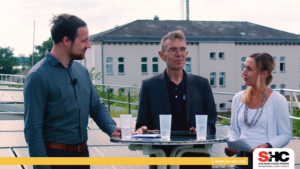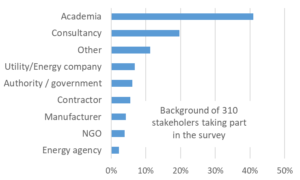Solar thermal achieves highest level of “real” climate neutrality
August 9, 2023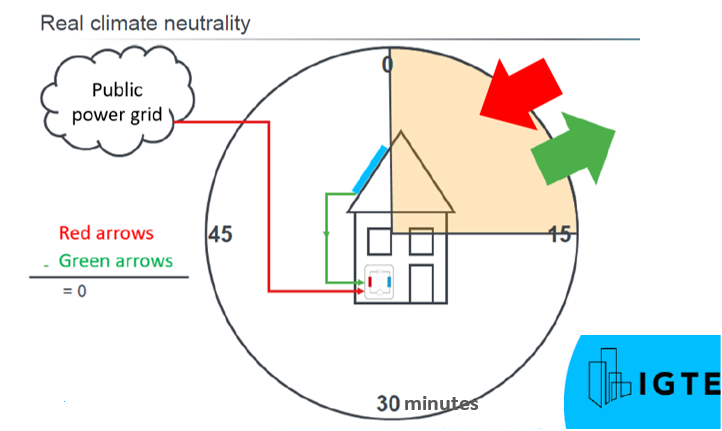
The term “climate neutral” is omnipresent today. But there is no generally accepted official definition of climate neutrality. Instead there are three definitions that have different impacts on the assessment of residential solar-energy-based systems. Harald Drück, Chair of IEA SHC Task 66 Solar Energy Buildings, calls these three approaches: virtual, balance sheet and real climate neutrality. In an extensive article published in the German Solar Thermal Yearbook 2023, he concludes that “real climate neutrality is the only way to achieve the global climate goals and also offers additional advantages for solar thermal energy, since energy storage is an integral part of such systems”. For practical purposes, a balance period of 15 minutes, as commonly used in the electricity sector, has also been used here (see chart above). Chart: IGTE
“Climate neutrality is currently defined very differently depending on individual motivation. We defined the three most relevant approaches and compared them for different solar-energy-based concepts for the heat and power supply of a single-family house by carrying out TRNSYS simulations,” said Drück, describing the methods used. His team carried out the work at the German-based Institute for Building Energetics, Thermotechnology and Energy Storage – IGTE at the University of Stuttgart. The theoretical single-family house has a usable floor space of 145 m2, is located in Würzburg, central Germany, and has an annual electricity demand of 3,500 kWh for household purposes and an annual heating demand of 11,000 kWh.
Drück´s final conclusion: Since only real climate neutrality can lead to global climate neutrality, it is important to apply this definition exclusively in the future. The comparison of different energy supply variants shows that a large solar thermal system for space heating with a moderately sized PV system causes the lowest CO2 eq emissions. The additional costs for this variant are around 300 EUR or less than 10 % per year in relation to a conventional energy supply system with a heat pump and PV. This clearly shows that appropriately designed solar energy systems using both solar thermal and PV, can significantly contribute to achieving real climate neutrality without huge additional costs – hence such concepts are one of the key aspects of IEA SHC Task 66 related to Solar Energy Buildings.
Definition of three climate neutrality concepts
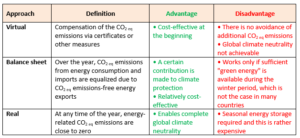
Comparison of three approaches for climate neutrality. All three approaches use CO2 (eq = equivalent) emissions. That means that the relevant gases besides CO2 such as methane and nitrous oxide are considered related to their global warming potential compared to CO2. Source: IGTE
Definition of four energy supply systems
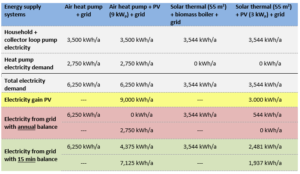
Table 1: Annual electricity flows within the four energy supply concepts. The air-to-water heat pump has a seasonal performance factor of 4. The 9 kWp PV system covers 30 % of the household electricity demand and 30 % of the heat pump electricity demand. The specific yield of the photovoltaic systems is set at 1,000 kWh/kWp. A 55 m2 collector field achieves 60 % annual solar fraction of the total heat demand for space heating and hot water. Source: IGTE
Table 1 shows that the definition of climate neutrality is decisive for the electricity flows into and out of the electricity grid. Both variants without a PV system, for example, have to cover their entire electricity demand from the public grid, while with an annual balance sheet approach over one year, the variants with PV systems either do not draw any electricity from the grid (variant air heat pump + PV), or significantly reduce the amount drawn from the grid to 544 kWh/a (variant solar thermal + PV). However, if the balance is calculated over a period of 15 minutes, the amounts of electricity from the grid are comparatively high, with 4,375 kWh/a for the concept with air heat pump + PV, because solar electricity from the roof is not always available when there is a demand for electricity for the heat pump or the household.
Comparison of emissions balances

Table 2: CO2 eq emissions that occur for the different energy supply concepts depending on the climate neutrality definition. The specific CO2 eq emissions for electricity are 0.399 kg/kWh and for biomass 0.029 kg/kWh. Positive values represent CO2 eq emissions generated and thus de facto released into the atmosphere. Source: IGTE
Table 2 shows that the lowest CO2 eq emissions and the highest credits can be achieved with the virtual approach. This is due to the fact that, on the one hand, the purchased electricity is green electricity and thus theoretically without CO2 eq emissions and, on the other hand, the generated PV electricity is completely fed into the grid and credited with 399 g CO2 eq/kWh.
This results in negative values for supposedly avoided CO2 eq emissions. Whereby Drück mentioned in the long version of the article that in reality the CO2 eq emissions that arise when electricity produced be fossil fuels is drawn from the grid to operate the heat pump in winter end up in the atmosphere, heating up the climate, and don’t disappear again when PV electricity is fed into the grid in summer.
“We assumed that in the real climate neutrality approach the surplus PV electricity cannot be fed into the grid, or only to a small extent, because all other PV systems installed in the vicinity also feed into the grid at the same time. This means that the grid is already green and there are no CO2 eq emission credits,” explained Drück. Under these conditions, which will become reality if we all go for climate neutrality, the large solar thermal system for space heating together with a moderately sized PV system for partial coverage of the household electricity demand achieve by far the lowest CO2 eq emissions of 1,100 kg/a.
Comparing additional costs for climate-neutral energy supply systems

Table 3: Additional costs including VAT in Germany of the different energy supply systems in relation to the air heat pump system with grid connection. Determination of the investment costs: EUR 31,500 for solar thermal system with 55 m2 (25 years useful life), EUR 20,000 for air heat pump (15 years), 1,590 EUR/kW for PV system (25 years), EUR 7,000 for biomass boiler (20 years). Feed-in tariff for partial self-consumption of PV electricity: 0.08 EUR/kWh and for complete feed-in of PV electricity: 0.12 EUR/kWh, specific biomass costs (fuel and maintenance) 0.09 EUR/kWh Source: IGTE
For a comparison of the additional costs of the different energy supply systems, the system “air heat pump” + grid” was selected as the basis or reference respectively (see table 3). In order to achieve virtual climate neutrality with this system, only the purchase of green electricity at an additional price of 0.01 EUR/kWh is required. The additional costs in this case are 6,250 kWh/a x 0.01 EUR/kWh = 62.50 EUR/a.
First of all, it is noticeable that the additional costs for achieving climate neutrality in the two variants with a solar thermal system depend little on the definition of climate neutrality, as there are no significant credits for PV electricity fed into the grid. In contrast, the additional costs for the “air heat pump + PV” system change by a maximum of 596 EUR/a depending on the approach chosen to define climate neutrality, i.e. from -302 EUR/a for the virtual approach to 294 EUR/a for the real approach.

Table 4: Comparison of the energy supply concept in the real climate neutrality approach. Source: IGTE
The decisive factor is now a comparison of the energy generation systems within the targeted “real climate neutrality” (see Table 5). In the first step, “air heat pump + PV” saves CO2 eq emissions of 748 kg/a at additional costs of EUR 232. If the heat pump is then replaced by a large solar thermal system in combination with a biomass heating system, the additional costs amount to EUR 597/a and save a total of 969 kg/a CO2 eq emissions. Particularly noteworthy is the fact that the concept consisting of a solar thermal system for space heating plus a 3 kW PV system reduces the additional costs by EUR 58 and at the same time the CO2 eq emissions can be reduced by 424 kg/a.
A long version of this article appeared in German in the Solar Thermal Yearbook 2023: https://www.solarthermie-jahrbuch.de/
Websites of organizations mentioned in this news article:
Task 66: https://task66.iea-shc.org/
